In the post that launched this blog last fall, I wrote about how much fun it is to actually be in a place that’s part of a story you’re reading. I invited readers to suggest place-specific stories that I’d enjoy reading on this yearlong adventure along the Edges of America. (I got some thousand suggestions, which I’m still delightfully wading through!)
I also described how I looked forward to reading Midnight in the Garden of Good and Evil by John Berendt while in Savannah, Georgia and visiting – experiencing – some of the places that played key roles in the story.
I came, I read, I experienced.
It was fabulous.

The book, published in 1994 and a longstanding best seller, ostensibly is about the shooting by respected antiques dealer Jim Williams of a young male prostitute described memorably by a local socialite as “a good time not yet had by all.” Three murder trials found Williams guilty of murder, despite his money, connections and claims of self defense. A fourth acquitted him; Williams died suddenly a short time later.
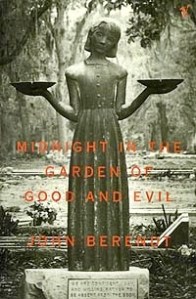
But the book is really about the variety of eccentric characters in and around Savannah, the city’s renowned self absorption and the mores and customs of this Deep South coastal region. It reads like a novel and was a finalist for the Pulitzer Prize for non-fiction, a true-life story that has captured the imaginations of millions.
Among my favorite characters – remember, these are actual real people – are The Lady Chablis, an exceptionally witty and sexy drag queen; Minerva, a lowcountry root doctor/voodoo practitioner who cast spells for Jim Williams; and an inventor who takes pet insects for walks and is believed to possess a vial of poison strong enough to wipe out the entire city’s water supply.
And that’s just for starters. Citing all my favorite characters would result in a blog post longer than the Savannah River.
Clint Eastwood even made a 1997 film from the story starring Kevin Spacey and John Cusack. (It’s a film I recommend skipping entirely – a rare Eastwood flop that has all the wit and pacing of a block of wood. Small wonder: One report I read said Eastwood hadn’t even read the book when he signed onto the screenplay.)
Berendt memorably quotes in Chapter 2 a white-haired Savannahian describing her city:
If you go to Atlanta, the first question people ask you is, ‘What’s your business?’ In Macon they ask, ‘Where do you go to church?’ In Augusta they ask your grandmother’s maiden name.
But in Savannah the first question people ask you is ‘What would you like to drink?’
So one of the first things I did upon arriving in Savannah on a recent Friday morning was make a reservation for a two-hour “Midnight” book tour with Angela of Savannah Heritage Tours. I was joined by New Good Friend Judy, who works at the Savannah Convention Center where we had gotten acquainted as Georges and I signed up to overnight in the exhibitors parking lot.
(Judy and I bonded immediately: She drives an Xterra like ours; knows all about Casitas and is thinking of buying one herself; loves to travel, especially to Italy; is a fan of Painted Buntings, Jimmy Buffett and the Eagles; was born the same year I was; enjoys adventures and appreciates good food. We’ve already arranged for her to visit us in Dallas next year if she waits until then to pick up a newly ordered Casita from the family-owned factory in Rice, Texas.)
Angela, as it turns out, is a native Savannahian and a bit of a character herself – not to mention a walking-talking encyclopedia about the shooting, the book, its characters and all of Savannah.
And sass is her middle name.
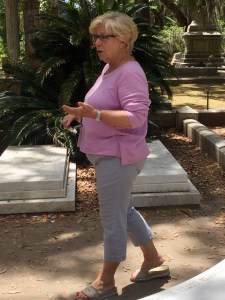
At one point, the sass to appropriately describe a typically sharp tete-a-tete she had a few years back with hairdresser Jerry Spence, one of the few characters in the book still alive today, required hand-on-hip re-telling. No small feat, given that Angela was simultaneously hypnotizing us with her charming Georgia drawl via her headset mike and threading our 15-passenger van through the tight streets and squares of Savannah with eye-of-a-needle precision.
(Sadly, it seems that Spence, who played himself in the Eastwood film adaptation of the book, is now homeless in a neighboring county.)
Angela started by driving us by the Jepson Center for the Arts, which is where the iconic “Bird Girl” statue made famous by the Jack Leigh photograph on the cover of the book currently resides. It used to be in the Bonaventure Cemetery, but was so overrun by tourists chipping pieces of it as souvenirs after the book was published that the owners reclaimed the statue and, ultimately, turned it over to the museum for appropriate viewing.
The Jepson is one of the Telfair museums. Angela was full of stories about 19th century Mary Telfair, who upon her death a few years after witnessing the occupation of Savannah by Gen. William Sherman’s troops bequeathed her home to become the original Telfair Museum. Telfair reportedly decreed that no alcohol or tobacco was ever to be consumed within her property’s confines.
This was a decree famously flouted by Jim Williams when hosting his signature parties at this lovely locale a century later.
From there, Angela showed us many of the 22 homes which Jim Williams elegantly restored, including the Mercer House, where the alleged “murder” took place. The house is named for the great-grandfather of famed singer-songwriter Johnny Mercer. Mercer senior commissioned it in the Civil War era. Williams purchased the house in 1968 for $30,000; it’s now called the Mercer-Williams house.
Savannah as a whole wasn’t wild about Berendt’s book when it first came out, according to Angela, because “it caused such a commotion with tourists and all.” But the community has clearly come around since, benefiting enormously from the money spent by the hundreds of thousands of tourists who flock to the city to see the places and people made famous by the book.
On our tour, Angela recommended another Midnight-related book, one published in 2015 called “Lawyer Games” by Dep Kirkland, the assistant DA at the time of the shooting who was at the crime scene when he made the surprise decision to arrest Williams and charge him with murder. She implied it comes to a less ambiguous conclusion about Williams’ guilt than the original Midnight book.
I’ve already downloaded the book to my Kindle.
I confess to not knowing a lot about Savannah prior to reading Midnight. It seems Berendt, a New York writer and editor who spent some eight years in Savannah, off and on, in writing the book, did a good job capturing the city’s idiosyncratic personality.
One of my favorite passages has Berendt describing the differences between Savannah and Charleston, particularly meaningful to me as we planned to visit Charleston shortly after our foray in Savannah. This is from Chapter 11:
Savannahians often talked about other places, as if they traveled a lot, but usually it was just talk. Savannahians liked to talk about Charleston most of all, especially in the presence of a newcomer. They would compare the two cities endlessly. Savannah was the Hostess City; Charleston was the Holy City (because it had a lot of churches). Savannah’s streetscape was superior to Charleston’s, but Charleston had finer interiors. Savannah was thoroughly English in style and temperament; Charleston had French and Spanish influences as well as English. Savannah preferred hunting, fishing, and going to parties over intellectual pursuits; in Charleston it was the other way around. Savannah was attractive to tourists; Charleston was overrun by them. On and on. In the minds of most Americans, Savannah and Charleston were sister cities. If so, the sisters were barely on speaking terms. Savannahians rarely went to Charleston, even though it was less than two hours away by car. But then Savannahians rarely went anywhere at all. They could not be bothered. They were content to remain in their isolated city under self-imposed house arrest.
I was impressed to learn from the book that Eli Whitney invented the cotton gin at Mulberry Plantation in Savannah and that Juliette Gordon Low founded the Girl Scouts of America in a carriage house on Drayton Street in 1912.
(I love the fact that the free passenger ferries we rode on back and forth across the Savannah River are called the “Southern Belles Ferries” and are named for four women who played important roles in shaping Savannah. In addition to Gordon Law, they are named for Susie King Taylor, who gained her freedom from slavery at age 14, served as nurse to black soldiers in Civil War, and opened one of Savanna’s first schools for African-American children before she died 1912; Florence Martus, the “waving girl” who reportedly waved her white handkerchief or a lantern in greeting to every ship that came in to port for the 44 years straddling the turn of the century; and Mary Musgrove, a Native American who served as an interpreter in the 18th century for Gen. Oglethorpe during the founding of Savannah, helping to convince the Tomochichi and Creek Indians to peacefully accept the new colony in their area.)
We spent a good part of the tour with Angela at Bonaventure Cemetery, where, in the book, Minerva communes with the dead and does some of her best spell-casting. (In reality, Minerva likely worked from a cemetery in Beaufort County just across the state line in South Carolina; call it literary license.)
There’s much to see in Bonaventure, related or unrelated to the book. For example, here is the grave of Josiah Tattnall III, a naval officer in the War of 1812 who coined the phrase: “Blood is thicker than water.”
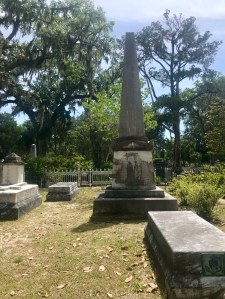
Several of the graves in this cemetery date to the mid-1700s.
The next photo is the burial square where the Bird Girl statue was before the book’s popularity required the family to move her.
“You wouldn’t believe how many people came here to find those nine shiny dimes,” Angela noted at one point, referring to the objects required for the casting of one of Minerva’s spells.
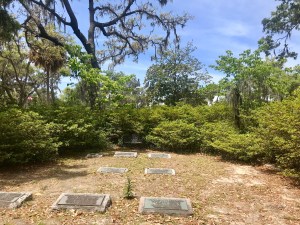
The cemetery is so large that people are constantly getting lost in it, according to Angela, even with the cemetery’s map clutched in their hands.
Occasionally there are “street” signs.
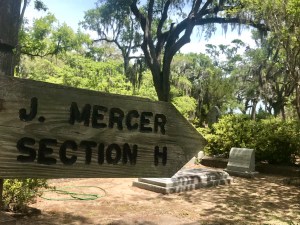
The photo here with the multiple headstones and large white cross is the Mercer burial square in Bonaventure, with the graves of Savannah native Johnny Herndon Mercer, his parents and other family members:
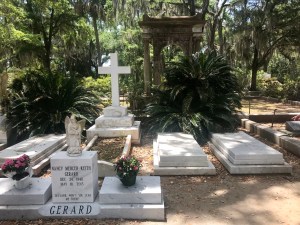
Here is the grave within that burial square of songwriter Mercer, the great-grandson of the Mercer who commissioned the now-famous house (but who never actually lived in it):
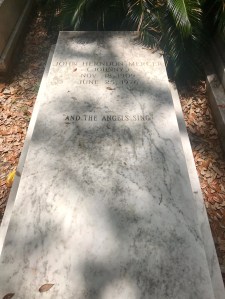
Johnny Mercer penned nearly 1,400 songs, co-founded Capitol Records and was the founding president of the Songwriters Hall of Fame.
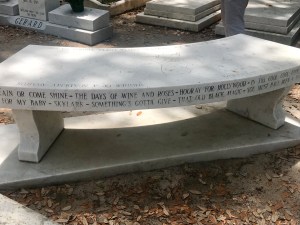
There’s also a lovely bronze statue of him near the City Market in downtown Savannah. Mercer was nominated for 18 Academy Awards, winning four Oscars. Most famous song: Moon River.
As you can see from the next photo, the Lawton family burial square is huge.
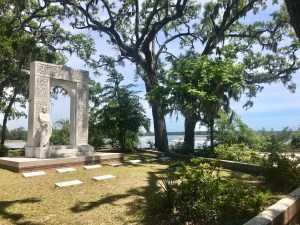
Spencer Lawton Jr. was the DA who prosecuted Williams and who Berendt describes as being generally regarded as a lightweight elected to office largely based on his name ID and family largesse. (Nonetheless, he did win three consecutive convictions prior to Williams’ final acquittal.)
The tombstones were all carved in Italy, according to Angela. (Can you see the boat sailing on Wilmington River in the background between the two tree trunks?)
I took pictures of several other headstone statues in the Bonaventure Cemetery that reportedly were considered for the cover of what the locals call simply “The Book.”
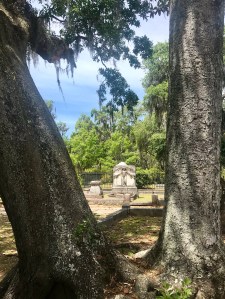
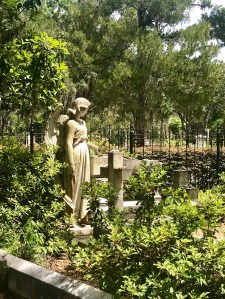
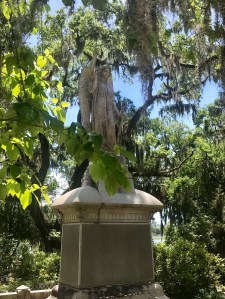
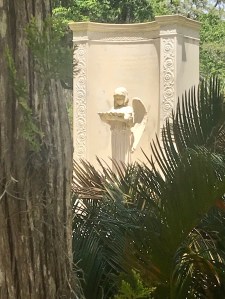
Footnote: The woman who sculpted Bird Girl in 1936, Sylvia Shaw Judson, isn’t buried in Bonaventure but the photographer who made her sculpture famous, Jack Leigh, is.
The $38 tour was supposed to last two hours. Fueled by her audience’s interest and Angela’s own boundless enthusiasm, it lasted more than three hours. I loved every minute of it.
Next time, maybe I’ll do the three-hour Midnight tour that takes place actually at midnight….

Keven! Catching up on your writings….have had a few things going on here back in Dallas 😉. My first visit to Savannah was in April to do the half marathon…13.1 check, 2 cold beers at the end, check check! What a fabulous city..did not get to do all that you did, but will be going back..thank you for the details 👍. Looking forward to reading more….safe casita travels!
LikeLiked by 1 person
Thanks, Katy. Congrats on that half marathon! Love keep up with you, Ken and Lyric on FB…. Wishing you all the best. Thanks for checking in on this blog. Hope you like it!
LikeLike
Fabulous post! We did not realize the Bird Girl had been sequestered until after a unsuccessful hunt for her at Bonaventure. Finally I asked someone and got the story. Mysteriously beautiful place!
LikeLiked by 1 person
So glad you solved the mystery! And that you enjoyed the post. Thanks for commenting!
LikeLike
Hi Keven! It was nice to meet you and Georges on your adventure while we were in Savannah! Thanks for sharing about the tour. Maybe we will go on it on one of our next visits there. Happy and safe travels to you both!
LikeLiked by 1 person
Thanks, Karen! It was nice to meet you and Matt and become “overnight neighbors!” So glad you like the post, and yes, do take Angela’s tour sometime. Hope we stay in touch and that our paths cross again one day!
LikeLike
I have always wanted to visit Savannah–in fact, if I had had a girl I wanted to name her Savannah. lol. But thank you for deepening my interest in going there!
LikeLiked by 1 person
Glad you liked the pot, Sheryl!
LikeLike
I loved that book, and reading your post makes me want to read it again — in Savannah.
LikeLiked by 1 person
Thanks, Cecilia. It was a fun experience to be sure. Do you think you will read Lawyer Games?
LikeLike
Charleston was spared in Sherman’s march to the sea. Savannah was not. There are hundreds of exquisite antebellum buildings in Charleston, but a lot of what’s in Savannah today wasn’t built until the decades after the Civil War. Sherman, I think, laid waste to much of what was there when he arrived.
LikeLiked by 1 person
Yes, much of what we saw would be labeled something like originally built in X year (before the Civil War) and rebuilt in X year (after the Civil War). Eager to experience Charleston now…!
LikeLiked by 2 people